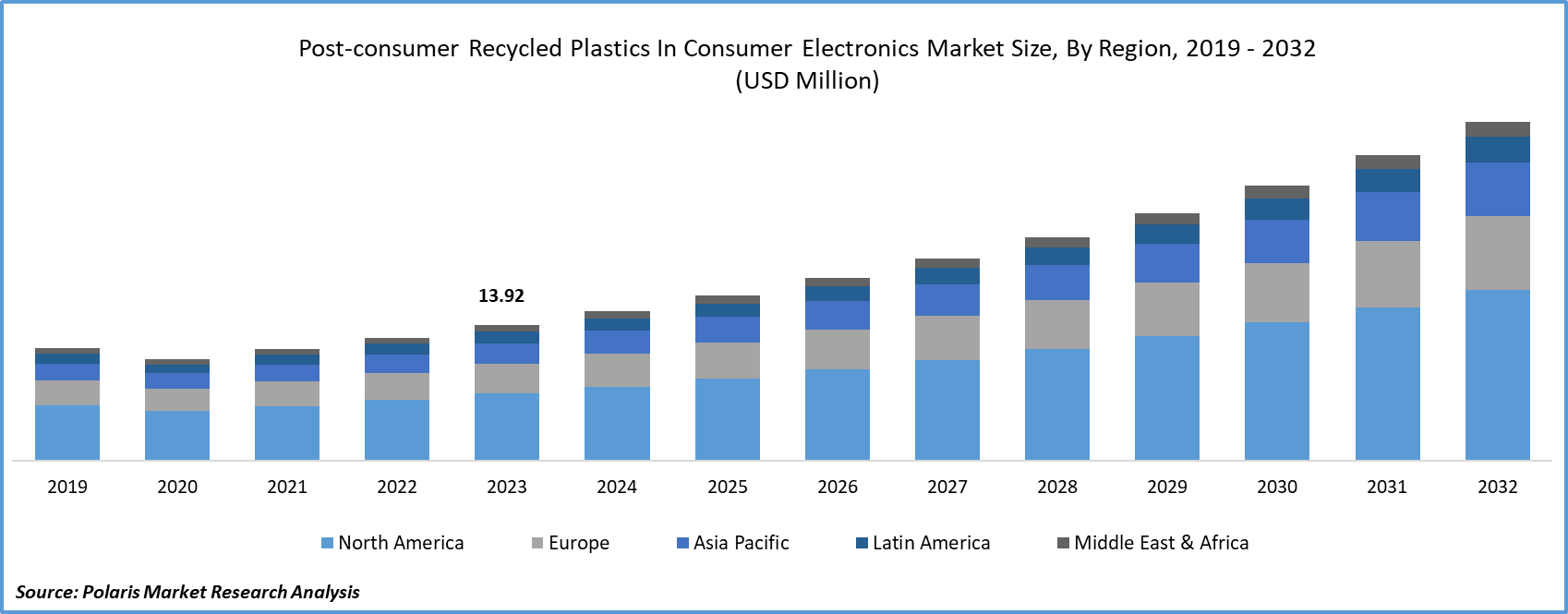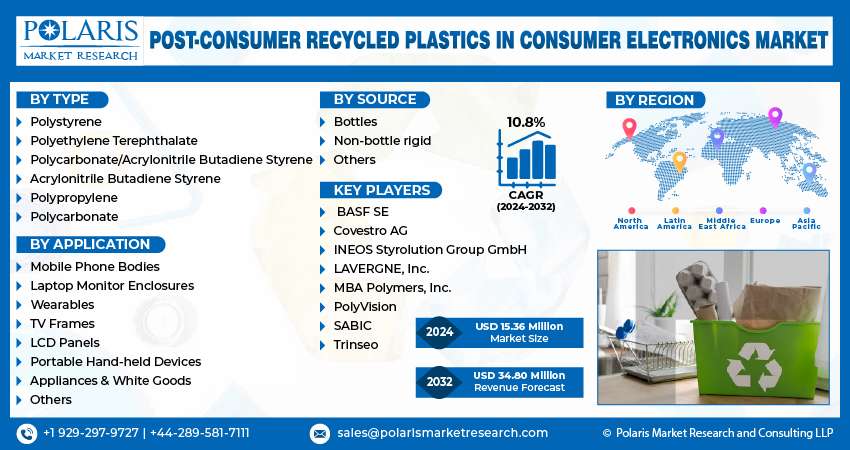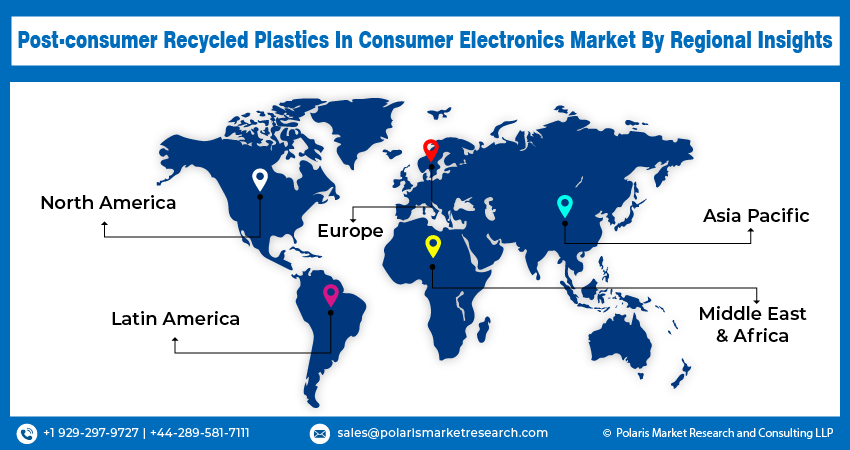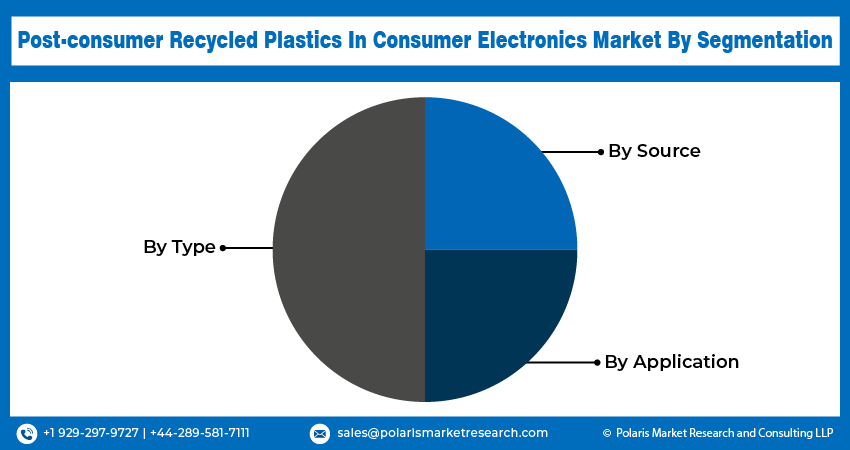
Post-consumer Recycled Plastics in Consumer Electronics Market Share, Size, Trends, Industry Analysis Report, By Source (Bottles, Non-bottle rigid, Others); By Type; By Application; By Region; Segment Forecast, 2024- 2032
- Published Date:Feb-2024
- Pages: 118
- Format: PDF
- Report ID: PM4552
- Base Year: 2023
- Historical Data: 2019 – 2022
Report Outlook
Global post-consumer recycled plastics in consumer electronics market size was valued at USD 13.92 million in 2023. The market is anticipated to grow from USD 15.36 million in 2024 to USD 34.80 million by 2032, exhibiting the CAGR of 10.8% during the forecast period
Post-consumer Recycled Plastics in Consumer Electronics Market Overview
The Consumer Electronics Market is experiencing a notable transformation in Post-consumer Recycled Plastics, propelled by remarkable technological advancements that are redefining the electronics industry's stance on sustainability and waste reduction. The incorporation of post-consumer recycled plastics (PCR) in consumer electronics manufacturing signifies a crucial shift towards a more circular and environmentally conscious model.
A notable technological advancement in the Consumer Electronics Market's Post-consumer Recycled Plastics pertains to the development of advanced recycling technologies. Traditional recycling approaches faced challenges in producing electronic-grade plastics of high quality. Nonetheless, enhancements in both mechanical and chemical recycling processes have elevated the purification and quality of post-consumer recycled plastics. These technologies enable the retrieval of plastics from electronic waste, including discarded laptops and smartphones, transforming them into high-performance materials for manufacturing new electronic devices.
Furthermore, advancements in material science and polymer chemistry have resulted in the development of post-consumer recycled plastics possessing improved thermal, mechanical, and electrical properties. Scientists are fine-tuning the composition of recycled plastics to fulfill the precise needs of consumer electronics, ensuring that these materials not only meet performance standards but also enhance the overall durability and functionality of electronic devices. This progressive post-consumer recycled plastics in consumer electronics trend is pivotal in meeting the industry's requirement for sustainable materials while maintaining the technical specifications of electronic components.

To Understand More About this Research: Request a Free Sample Report
The incorporation of intelligent design and engineering approaches represents a significant technological trend in the Consumer Electronics Market's Post-Consumer Recycled Plastics. Designing electronics with considerations for disassembly and recyclability streamlines the effective retrieval of materials at the product's end-of-life stage. This transition towards circular design principles promotes the utilization of post-consumer recycled plastics, establishing a closed-loop system that lessens waste and mitigates the environmental footprint of electronic devices.
Embracing industry-wide standards and certifications is a technological advancement geared towards encouraging the conscientious use of post-consumer recycled plastics in consumer electronics. Standardization guarantees that recycled materials meet defined criteria, including composition, purity, and performance. Certifications like Recycled Content Certification and Electronic Product Environmental Assessment Tool (EPEAT) provide transparency and assurance to both consumers and manufacturers concerning the recycled content and environmental impact of electronic devices.

Post-consumer Recycled Plastics in Consumer Electronics Market Dynamics
Market Drivers
Growing interest in environmentally friendly materials for consumer electronics bolstering the Post-consumer Recycled Plastics In Consumer Electronics Market growth of the market.
The global post-consumer recycled plastics market is witnessing a significant upswing, propelled by the increasing desire for sustainable materials within the consumer electronics industry. Post-consumer recycled plastics sourced from used plastic products offer an effective solution to the environmental challenges posed by traditional plastics. With the consumer electronics sector facing growing pressure to embrace sustainability and reduce its carbon footprint, there is a rising demand for post-consumer recycled plastics, making them a crucial element in the pursuit of more environmentally friendly manufacturing practices.
A key factor driving the increased demand for post-consumer recycled plastics is the growing awareness of environmental sustainability among consumers and manufacturers in the consumer electronics industry. Given the integral role of electronic devices in modern life, there is heightened emphasis on mitigating the environmental impact associated with their production and disposal. Post-consumer recycled plastics, sourced from discarded electronic devices and other origins, embody a circular and eco-friendly approach to material resourcing. As consumers increasingly prioritize sustainable products, electronic manufacturers are compelled to integrate recycled plastics into their production processes, aligning with global sustainability objectives.
The demand for sustainable materials in consumer electronics goes beyond environmental concerns to include regulatory requirements and initiatives driven by the industry. Numerous countries and regions are implementing rigorous regulations and standards to address the environmental consequences of plastic waste. In reaction, electronic manufacturers are exploring alternatives to traditional plastics and are increasingly incorporating post-consumer recycled plastics as a crucial component in their portfolios of sustainable materials. Moreover, initiatives and certifications led by the industry, such as e-Stewards and R2 (Responsible Recycling), actively encourage the responsible management and recycling of electronic waste, promoting the integration of post-consumer recycled plastics in electronic manufacturing.
Furthermore, the adoption of post-consumer recycled plastics in consumer electronics aligns with the principles of a circular economy, where resources are utilized, reused, and recycled to minimize waste and environmental impact. Manufacturers are increasingly recognizing the value of incorporating recycled content into their products, not only for environmental sustainability but also to meet the evolving expectations of environmentally conscious consumers. The circularity of post-consumer recycled plastics complements the lifecycle of electronic devices, contributing to the reduction of greenhouse gas emissions, energy consumption, and the overall environmental footprint of the consumer electronics industry.
Market Restraints
Challenges in the Application of PCR Plastics are likely to hamper the growth of the market.
The application of post-consumer recycled (PCR) plastics faces notable technical challenges that hinder the market expansion of global Post-consumer Recycled Plastics in the Consumer Electronics sector. The exacting requirements for precision, durability, and aesthetic features in consumer electronic products introduce complexity to the integration of PCR plastics. Obstacles like variable material composition, potential degradation during recycling processes, and difficulties in achieving consistent quality standards create barriers to the seamless incorporation of PCR plastics in electronics manufacturing.
Tackling these challenges necessitates focused research and development initiatives, the adoption of innovative processing technologies, and collaborative efforts within the industry to establish standardized practices. Overcoming these technical hurdles enables industry stakeholders to enhance the performance and reliability of PCR plastics, making them more suitable for use in consumer electronics. Consequently, this contributes to the sustainable growth of the Post-consumer Recycled Plastics market in the global consumer electronics sector.
Report Segmentation
The market is primarily segmented based on type, source, application, and region.
|
By Type |
By Source |
By Application |
By Region |
|
|
|
|
To Understand the Scope of this Report: Speak to Analyst
Post-consumer Recycled Plastics in Consumer Electronics Market Segmental Analysis
By Source Analysis
- The non-bottle rigid sector secured the largest market share in 2023, experiencing significant market growth in plastic recycling. This growth is attributed to the increased purchase of challenging-to-recycle items like mixed resin rigid bales by exporters, along with the global expansion of the recovery and manufacturing of these commodities.
In the plastic bottle recycling process, majorly utilized resins include polyethylene terephthalate (PET) and high-density polyethylene (HDPE). HDPE, known for its lightweight and high durability properties, is employed in the production of items such as mobile phone cases and laptop enclosures. Additionally, the growing demand for electronics, particularly mobile phones and laptops, has positively influenced the demand for plastic bottles as a raw material for post-consumer recycled plastics.
By Type Analysis
- The polycarbonate (PC) segment dominated the market revenue share in the forecast period. Post-consumer recycled polycarbonate (PC) resins exhibit characteristics such as increased toughness and impact strength, light transmittance, protection against ultraviolet (UV) radiations, as well as chemical and heat resistance. These properties make them well-suited for applications in components of electrical and electronic devices, including television frames, mobile cases, and electrical housing.
- Recycled PC/ABS is anticipated to experience the fastest CAGR during the forecast period. This blend is characterized by improved processing, high heat resistance, flexibility, impact strength, and biocompatibility, making it well-suited for the production of electronic housings for various devices. The increasing demand for post-consumer recycled PC/ABS within the electrical and electronics industry is expected to drive market size throughout the forecast period. Additionally, post-consumer recycled PET resin provides mechanical, thermal, and chemical resistance along with dimensional stability, similar to PET resin. Moreover, it is ideal for manufacturing TV frames and laptop enclosures due to its properties, such as high impact capability, stiffness, shatter resistance, hot filling capability, and its role as an excellent barrier to moisture, water, and gas. These market segmentation attributes to the growth of the market size.
Post-consumer Recycled Plastics in Consumer Electronics Market Regional Insights
The Asia Pacific region dominated the global market with the largest market share in 2023
The anticipated growth in the Asia Pacific construction industry in the foreseeable future is attributed to the rising demand for non-residential construction ventures, including schools, hospitals, and colleges. This surge is expected to boost the demand for personal protective equipment products such as helmets, safety vests, safety belts, and various other items, consequently driving industry expansion, and contribute to increase the post-consumer recycled plastics in consumer electronics market revenue.
North America is poised to experience significant growth in the consumer electronics sector using post-consumer recycled plastics. This market expansion is propelled by the growth of major end-use industries, including electrical and electronics, construction, and packaging. Anticipated factors contributing to market scope in the near future include the increasing demand for packaged and processed food and the flourishing construction industry in the U.S., Mexico, and Canada. The rise in awareness about landfill issues, the desire to reduce the carbon footprint, regulatory frameworks, and consumer preference for sustainable products are expected to drive the demand for post-consumer recycled plastics in consumer electronics applications over the forecast period. Organizations such as the Association of Plastic Recyclers (APR), Waste360, National Waste & Recycling Association, Solid Waste Association of North America, and NAPCOR are actively involved in raising awareness about plastic waste recycling in the region.

Competitive Landscape
The Post-consumer Recycled Plastics in the Consumer Electronics market is fragmented and is anticipated to witness competition due to several players' presence. Major service providers in the market are constantly upgrading their technologies to stay ahead of the competition and to ensure efficiency, integrity, and safety. These players focus on partnership, product upgrades, and collaboration to gain a competitive edge over their peers and capture a significant market share.
Some of the major players operating in the global market include:
- BASF SE
- Covestro AG
- INEOS Styrolution Group GmbH
- LAVERGNE, Inc.
- MBA Polymers, Inc.
- PolyVision
- SABIC
- Trinseo
Recent Developments
- In April 2023, Indorama Ventures and Evertis announced a partnership to produce PET film for food packaging trays, utilizing PET flakes derived from recycled PET trays. This collaboration is instrumental in assisting Evertis in achieving its objective of incorporating 50% post-consumer recycled content in its products by the year 2025.
- In February 2023, Loop Industries, SUEZ, and SK Geocentric jointly revealed plans to establish a manufacturing site for virgin-quality PET plastic produced entirely from 100% recycled content in the Grand Est region of France. The trio aims to commence construction in early 2025, with the commissioning of the plant expected in 2027.
- In January 2022, Gamma Communications plc declared its adoption of Thales' Eco-SIM cards as a step towards enhancing its environmental sustainability. Gamma aims to further its collaboration with Thales by implementing Eco-SIM cards throughout its network of channel partners and business mobile clients.
Report Coverage
The Post-consumer Recycled Plastics in Consumer Electronics market report emphasizes key regions across the globe to provide a better understanding of the product to the users. Also, the report provides market insights into recent developments and trends and analyzes the technologies that are gaining traction around the globe. Furthermore, the report covers an in-depth qualitative analysis pertaining to various paradigm shifts associated with the transformation of these solutions.
The report provides a detailed analysis of the market while focusing on various key aspects such as competitive analysis, type, source, application, and futuristic growth opportunities.
Post-consumer Recycled Plastics in Consumer Electronics Market Report Scope
|
Report Attributes |
Details |
|
Market Size Value in 2024 |
USD 15.36 million |
|
Revenue Forecast in 2032 |
USD 34.80 million |
|
CAGR |
10.8% from 2024 – 2032 |
|
Base Year |
2023 |
|
Historical Data |
2019 – 2022 |
|
Forecast Period |
2024 – 2032 |
|
Quantitative Units |
Revenue in USD million and CAGR from 2024 to 2032 |
|
Segments covered |
By Type, By Source, By Application, By Region |
|
Regional Scope |
North America, Europe, Asia Pacific, Latin America; Middle East & Africa |
|
Customization |
Report customization as per your requirements with respect to countries, regions, and segmentation. |
FAQ's
The Post-consumer Recycled Plastics in Consumer Electronics Market report covering key segments are type, source, application, and region.
Post-consumer Recycled Plastics in Consumer Electronics Market Size Worth $34.80 Million By 2032
Global post-consumer recycled plastics in consumer electronics market exhibiting the CAGR of 10.8% during the forecast period
Asia Pacific is leading the global market
key driving factors in Post-consumer Recycled Plastics in Consumer Electronics Market are • Growing interest in environmentally friendly materials for consumer electronics

